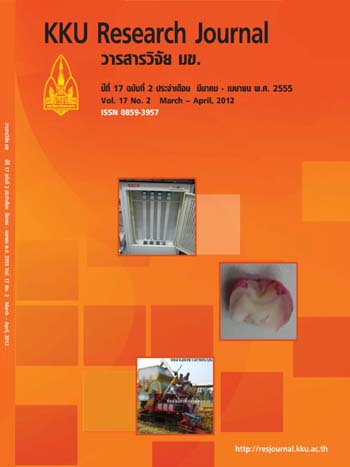Batch fermentation of sugar cane juice for producing biopolymer of PHAs
Main Article Content
Abstract
Potential of sugar cane juice for producing biopolymer of polyhydroxyalkanoates (PHAs) via batch
fermentation by two pure bacterial strains of Alcaligenes latus TISTR 1403 and Alcaligenes eutrophus TISTR
1095 is evaluated. The results revealed that sugar cane juice composed of several kinds of sugars. Then, the A.
latus and the A. eutrophus were separately cultivated in the 100 mL medium containing 20 gL-1 total sugar under
controlled conditions of 30ºC, 200 rpm, pH 6.5-7 and with 10% inoculums size. It was found that the A. eutrophus
grown better than the A. latus. Thus, the A. eutrophus was further cultivated in different initial total sugar concentrations
(20, 30, 40 and 50 gL-1) under controlled conditions (200 rpm, 30°C, pH 6.5-7 and 10% inoculums size).
The optimal total sugar concentration of 50gL-1 was reached. The dry cell mass (DCM) and maximum PHAs were
obtained at 6.013 gL-1 and 1.84 gL-1 after 60 hr fermentation converted to biomass yield (Yx/s) and product yield
(Yp/s) of 0.163 and 0.050 gL-1h-1. Meanwhile, specifi c product yield (Yp/x) and productivity were 0.306 and 0.031
gL-1h-1. To increase the PHAs production, 5 L fermentor (2 L working volume) was considered using the condition
obtained from the fl ask scale. The DCM and the maximum PHAs were 5.881 gL-1and 1.281 gL-1 calculated
to values of Yx/s, Yp/s, Yp/x and productivity at about 0.19, 0.041, 0.218 and 0.028 gL-1h-1, respectively.


